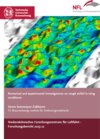Numerical and experimental investigations on rough airfoil in icing conditions
von Denis Sotomayor-ZakharovThis work presents the numerical study of the convective heat transfer of a flow over non-homogeneous rough surfaces obtained from ice accretion experiments on an airfoil. This supports the study of inflight ice accretion over aircraft components, a phenomenon that poses a risk to the safe operation of aircraft. The study of the convective heat transfer is of utter importance since it dictates the ice growth rate on a surface, especially in icing conditions favoring glaze ice formation. Therefore, icing codes, which permit the numerical simulation of ice accretion, require the proper modeling of the convective heat transfer on the boundary layer of a flow under the influence of non-homogeneous roughness. This allows to accurately obtain ice geometries to subsequently study their effects on aircraft aerodynamics.
The numerical study is performed on experimentally obtained ice shapes on an asymmetric airfoil. The experiments are carried out in the Braunschweig Icing Wind Tunnel, involving supercooled water droplets which follow Appendix C conditions of the EASA regulations. The obtained ice shapes were digitized via the photogrammetry method for their subsequent analysis and preparation for the numerical simulations. Embedded LES (ELES) is performed for the numerical study, which allows the simulation of unsteady 3D turbulent behavior in the region surrounding the ice geometry, typically located on the stagnation point of the airfoil, while the rest of the fluid is simulated via a RANS approach. The results obtained from the ELES are analyzed and compared to the ones of fully turbulent RANS simulations (SST with roughness model), from which several observations are elaborated.
First, ELES shows that the wall shear stress and heat flux do not possess a direct correlation in the presence of roughness, in contrast to smooth surfaces, which show a linear correlation between the skin friction coefficient with the Stanton number, as observed in experiments found in the literature. On the other hand, RANS results show a linear behavior between the skin friction coefficient and the Stanton number even in the presence of roughness. This results in an excessive heat transfer on rough regions and an overprediction of the ice growth towards the stagnation point in contrast to ELES.
Then, ELES shows that the roughness induces the transition process of the boundary layer, although, occurring around locations with high levels of roughness, away from the stagnation point. This results in a wide region with a laminar boundary layer, covering a notable portion of the ice surface, on which roughness does not have any effect on the heat transfer. On the other hand, the fully turbulent RANS tends to trigger the boundary layer transition too early, resulting in an instant growth of the convective heat transfer near the stagnation point.
Next, it is observed in the ELES that the wall shear stress and heat transfer tend to increase as the boundary layer flows over a surface with increasing roughness. Peak values are achieved at the location with the highest roughness, from which they subsequently decay independently of the roughness levels located in the path of the boundary layer, implying a dynamical behavior of the boundary layer (e. g., separation due to high roughness elements) not accounted in RANS, since the later shows a direct correlation of the wall shear stress and heat transfer to the local roughness levels.
After that, ELES exhibits the existence of longitudinal vortices around the stagnation point in the presence of spatial variations of pressure, being these generated by the curvature of the mean ice geometry. These vortices are 3D and unsteady in nature and tend to increase the heat transfer around the stagnation point, which is a phenomenon not accounted for in RANS models.
Finally, it is shown that these pressure variations do not have any further effect on the heat transfer away from the stagnation point, especially in rough zones, indicating that the heat transfer is mostly dominated by the characteristics of roughness and not the mean ice geometry, although it is noted that the studied cases do not exhibit phenomena such as massive flow separation, which can eventually affect the heat transfer.
The numerical study is performed on experimentally obtained ice shapes on an asymmetric airfoil. The experiments are carried out in the Braunschweig Icing Wind Tunnel, involving supercooled water droplets which follow Appendix C conditions of the EASA regulations. The obtained ice shapes were digitized via the photogrammetry method for their subsequent analysis and preparation for the numerical simulations. Embedded LES (ELES) is performed for the numerical study, which allows the simulation of unsteady 3D turbulent behavior in the region surrounding the ice geometry, typically located on the stagnation point of the airfoil, while the rest of the fluid is simulated via a RANS approach. The results obtained from the ELES are analyzed and compared to the ones of fully turbulent RANS simulations (SST with roughness model), from which several observations are elaborated.
First, ELES shows that the wall shear stress and heat flux do not possess a direct correlation in the presence of roughness, in contrast to smooth surfaces, which show a linear correlation between the skin friction coefficient with the Stanton number, as observed in experiments found in the literature. On the other hand, RANS results show a linear behavior between the skin friction coefficient and the Stanton number even in the presence of roughness. This results in an excessive heat transfer on rough regions and an overprediction of the ice growth towards the stagnation point in contrast to ELES.
Then, ELES shows that the roughness induces the transition process of the boundary layer, although, occurring around locations with high levels of roughness, away from the stagnation point. This results in a wide region with a laminar boundary layer, covering a notable portion of the ice surface, on which roughness does not have any effect on the heat transfer. On the other hand, the fully turbulent RANS tends to trigger the boundary layer transition too early, resulting in an instant growth of the convective heat transfer near the stagnation point.
Next, it is observed in the ELES that the wall shear stress and heat transfer tend to increase as the boundary layer flows over a surface with increasing roughness. Peak values are achieved at the location with the highest roughness, from which they subsequently decay independently of the roughness levels located in the path of the boundary layer, implying a dynamical behavior of the boundary layer (e. g., separation due to high roughness elements) not accounted in RANS, since the later shows a direct correlation of the wall shear stress and heat transfer to the local roughness levels.
After that, ELES exhibits the existence of longitudinal vortices around the stagnation point in the presence of spatial variations of pressure, being these generated by the curvature of the mean ice geometry. These vortices are 3D and unsteady in nature and tend to increase the heat transfer around the stagnation point, which is a phenomenon not accounted for in RANS models.
Finally, it is shown that these pressure variations do not have any further effect on the heat transfer away from the stagnation point, especially in rough zones, indicating that the heat transfer is mostly dominated by the characteristics of roughness and not the mean ice geometry, although it is noted that the studied cases do not exhibit phenomena such as massive flow separation, which can eventually affect the heat transfer.






